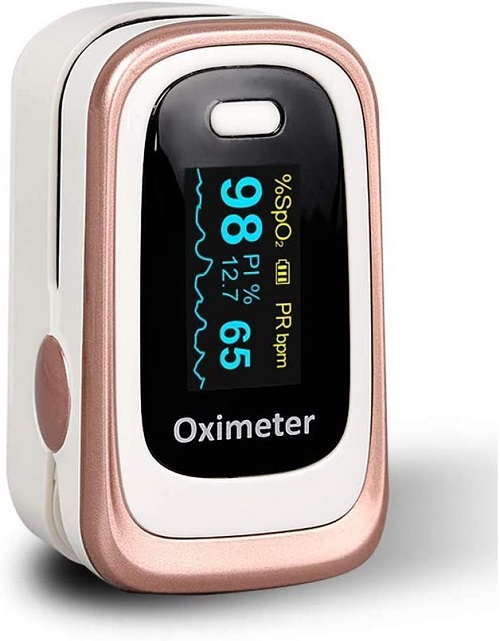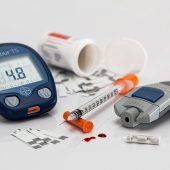A pulse oximeter measures the amount of oxygen in your blood. It is typically used on extremities such as fingers, toes or an earlobe to check how well your heart is delivering oxygen to your furthest body parts.
All cells in your body, from your head to your toes, need oxygen to function. It is the responsibility of your lungs and heart to deliver oxygen throughout the body.
However, usually because of a health condition, you may have low blood oxygen levels. This can lead to a condition called hypoxemia with symptoms like shortness of breath, headaches, visual problems and confusion.
In the hospital, doctors usually use an ABG test to check blood oxygen levels with high accuracy. At home, the most convenient way to monitor your blood oxygen saturation is using a pulse oximeter.
Unlike an ABG test, a pulse oximeter is non-invasive. You do not need to draw blood. You simply clip it to your fingertip and read the measurements. The pulse oximeter will indicate oxygen saturation (SpO2) in your blood as well as current heart rate.
In this buying guide, we review the top five pulse oximeters for personal health. They are great for managing certain condition such as asthma, fitness monitoring and overall wellness.
Read also: How To Choose The Best Home Cholesterol Test Kit?
Key Considerations When Buying a Pulse Oximeter
A. Measurements
Any pulse oximeter should offer at least two measurements: oxygen saturation and pulse rate.
Oxygen saturation is the measure of the amount of oxygen in your blood. Some oximeters will label it as SpO2. It will be displayed in percentage. In a healthy person, normal SpO2 is between 94% and 100%. If you get a reading below 90%, talk to your doctor as it could indicate low oxygen levels in your blood.
Pulse rate is simply the heart rate in beats per minute (bpm). Pulse rate varies depending on gender, age, health and fitness.
Some pulse oximeters will also indicate a bar graph showing pulse intensity, or how strong your pulses are. Others also show a pulse waveform that provides additional information about your heart function.
But the two most important measurements are SpO2 and bpm.
B. Display
Most pulse oximeters have a small OLED display. OLED is one of the best types of displays. It’s used in most high-end smartphones.
OLED screens are easy to see even in bright sunlight, meaning you can take readings even when outside. If you are on a budget, look for cheaper oximeters that have an LED screen. Though not as sharp as OLED, LED is still easy to see in different lighting conditions.
Check if the display has adjustable brightness. This provides comfortable viewing in different light conditions.
Read also: How To Choose The Best Blood Pressure Meter?
C. Auto-off
Most pulse oximeters use a pair of AAA batteries. To ensure the batteries don’t deplete too quickly, check whether the device has an auto-off function, where it switches off automatically if you don’t press a button for several seconds.
Thanks to the auto-off feature, most pulse oximeters can last well over one year before you need to replace the batteries.
D. Portability
Pulse oximeters are small devices; small enough to fit in your pocket. For even easier and safer portability, look for a pulse oximeter that includes a carry bag and a lanyard.
A lanyard is especially convenient for active users who’d like to take the device with them when hiking, running or cycling.
E. Ease of Use
A pulse oximeter should be easy to use. Most feature a one-button operation. You clamp the device onto your finger and press the button to take oxygen and pulse measurements.
Ease of use is especially important if you are buying a pulse oximeter for an elderly family member. They should be able to operate it on their own.
One feature to look for when it comes to ease of use is a multi-direction display. Some pulse oximeters use a screen that can show readings the right way no matter how you’ve turned the screen. It’s like when you turn on the auto-rotate feature on your smartphone.
A rotating display allows you to test different fingers from different positions without worrying about orienting the screen the right way.
Best Pulse Oximeters: Top 5 Reviews
1. HYLOGY Pulse Oximeter Review
The HYLOGY Pulse Oximeter accurately measures pulse rate and blood oxygen saturation. For SpO2, it has an accuracy of ±2% and a resolution of 1%. For heart rate, accuracy is ±2 bpm with a resolution of 1 bpm.
The screen is small but it’s very clear and displays readings in large numbers. Because it is OLED, you can see readings clearly even when outside.
In addition to oxygen and pulse rate measurements, the screen also displays your pulse intensity in form of a bar graph as well as a pulse waveform. You’ll also hear a beeping sound that corresponds to your heart rate. It’s a nice auditory way to experience your heart rate.
The HYLOGY Pulse Oximeter has a single button that you use to turn it on. Press the same button to rotate the display to the most convenient orientation.
You don’t need to turn the device off; it’ll automatically turn off after eight seconds.
As for accessories, you’ll get a neck/wrist lanyard, a carry bag and 2 AAA batteries.
What we like about it:
- Easy to use.
- Rotating display.
- Soft silicone mat feels comfortable when you clamp the device onto your finger.
- Auto-off function extends battery life.
2. PRCMISEMED Pulse Oximeter Review
The PRCMISEMED Pulse Oximeter offers simple, accurate and fast SpO2 and bpm testing. Similar to most other devices, PRCMISEMED is a one-button pulse oximeter, so anyone should be able to self-test.
To prevent any pressure or discomfort, the PRCMISEMED pulse oximeter uses a soft silicone mat. It takes about 10 seconds to take and display readings on the OLED screen.
The display shows four main things: SpO2 levels in percentage, pulse rate in bpm, a pulse waveform and a perfusion index or PI measurement.
That last one is not available in all pulse oximeters and can be confusing for many users. Perfusion index is the ratio of pulsing to non-pulsing blood. PI measurement indicates pulse strength. It is important in determining whether there’s enough blood flowing to the extremities like your toes and fingers.
PI ranges between 0.02% for a weak pulse and 20% for a strong pulse. Normal PI is different for everyone depending on age, health and current circumstances. You may get a different reading at different times.
Don’t worry about the PI number too much (it’s mostly helpful in a clinical setting); the ones to focus on are SpO2 and pulse rate.
Similar to the HYLOGY pulse oximeter, PRCMISEMED has a convenient rotating screen, which makes it easier to measure different fingers from any angle.
The sharp OLED display is easy to see even in bright sunlight.
The PRCMISEMED pulse oximeter runs on a pair of AAA batteries. A battery level indicator on the screen tells you when it’s time to get new batteries. Thanks to the 10-second auto-off function, you should get several months or more than a year out of the first pair of batteries.
By the way, the batteries are not included. You also don’t get a carrying case. The only accessory is a lanyard.
What we like about it:
- Easy to use – single button operation.
- Rotating screen.
- Multiple measurements including PI.
- Comes with a lanyard for easy portability especially when outdoors.
3. ATMOKO Pulse Oximeter Review
ATMOKO offers pretty much the same features and functionality as the other pulse oximeters. It’ll measure your heart rate and blood oxygen saturation and display the readings on a bright OLED display.
A bar graph and waveform tell you more about your pulse strength and intensity.
The accuracy for the SpO2 measurements is ±2% when you are at rest and ±3% after exercise. Accuracy goes down during vigorous activity, so we don’t recommend using the ATMOKO pulse oximeter during exercise. Take measurements either before or after a workout.
The OLED screen is bright and easy to read. One unique display feature of the ATMOKO pulse oximeter is that you can adjust brightness. There are five brightness levels to choose from. Make the screen brighter when you are outdoor and dimmer when you are in a low light environment.
Similar to the other oximeters, ATMOKO features a rotating display that makes it easier to see readings on the screen.
A pair of AAA batteries (which are included) powers the ATMOKO pulse oximeter. A 10-second auto-off function extends battery life to several months or more than a year depending on how often you self-test.
ATMOKO comes with all the accessories you need including the batteries, a carrying case to keep the oximeter safe and a lanyard to hang the oximeter from your neck when you are up and about.
What we like about it:
- Easy to use.
- Rotating display.
- Adjustable brightness.
- Comes with bag, batteries and lanyard.
4. MOMMED Pulse Oximeter Review

If you are on a budget, the MOMMED pulse oximeter is slightly cheaper than our other top picks. The reason the MOMMED pulse oximeter is cheaper is the LED screen, which is not as sharp as OLED.
Instead of the continuous font you get with OLED pulse oximeters, numbers on the MOMMED oximeter look like those on an old calculator.
But the screen is still easy to see; it’s bright enough for outdoor use. It can also rotate like in other oximeters. It is not automatic like in your smartphone; you have to press the button to change screen orientation.
Beyond the display, everything else is similar to other pulse oximeters. Once you clamp the device onto your finger, the screen displays your SpO2 and bpm after a few seconds. A bar graph shows you the intensity of your heart beat.
MOMMED is one of the few pulse oximeters that measure perfusion index. The screen displays PI in a small number at the bottom of the screen.
Depending on your pulse and oxygen saturation readings, you may hear an alarm. That indicates the readings are beyond the normal range. If that happens, record the readings and share them with your doctor.
The MOMMED pulse oximeter comes with a lanyard plus two AAA batteries.
What we like about it:
- Lower price.
- Flippable display.
- Easy one-button operation.
- Multiple measurements including PI.
5. Anapulse Finger Pulse Oximeter Review

Anapulse is another good choice if you are looking for a cheaper personal pulse oximeter. It uses an LED screen, but functionally, it’s just as good as pricier oximeters.
Anapulse measures blood oxygen concentration and pulse/heart rate and displays the numbers on the LED screen. Unfortunately, the display does not rotate so you have to make sure it is the right way up when clamping it on a finger.
In addition to bpm and SpO2, the screen also shows a bar graph that indicates pulse intensity.
Other notable features include battery-saving auto power off (after 8 seconds of inactivity) and a low battery indicator.
As for accessories, you get a carry case, two AAA batteries and a lanyard.
What we like about it:
- Affordable.
- Easy to use.
- Includes carry case, batteries and lanyard.
- Auto-off feature extends battery life.



